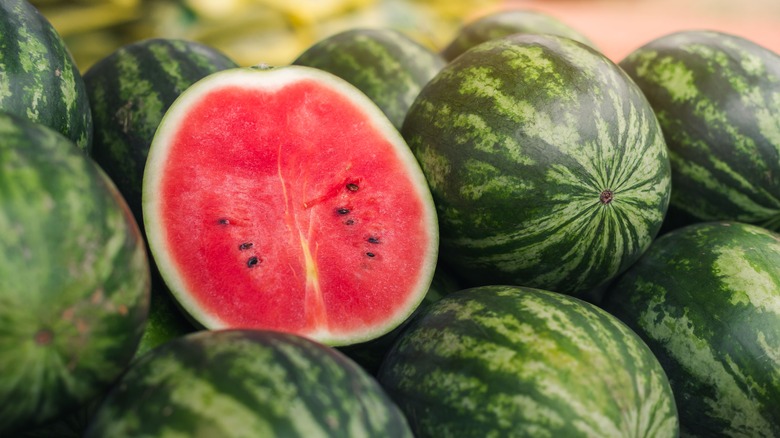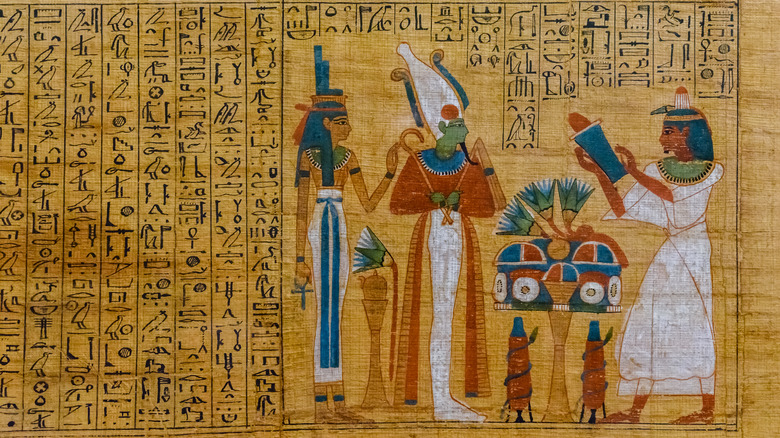Why Egyptian Pharaohs Took Watermelon To The Grave
According to ancient Egyptian beliefs, when pharaohs died and were buried, they didn't ascend straight to eternal bliss. First, they had to embark on extended journeys that ultimately led to the afterlife. In order to make their passages more comfortable, they were buried with certain essential items like money, clothing, furniture, and even pets. More recent archeological discoveries have also uncovered watermelon seeds and paintings of the fruit on the walls of 4,000-year-old Egyptian burial chambers. Why would melons make an appearance in such a sacred place?
It's believed that watermelons were present not for food, but for water. The species discovered were bitter and unpleasant, not like the sweet, refreshing fruit we know watermelon to be today. However, even way back then, they retained water like no other fruit, and when you're trekking through to eternity, heaven only knows what kind of conditions would be on your way, so you're probably going to get thirsty. Remember, bullet trains and private jets wouldn't be available to royalty for millennia so even the pharaohs had to rough it when they traveled, and watermelon provided needed sustenance.
Watermelon was meant to last an eternity
Pharaohs weren't the only ones who needed water on their post-life passages; their animals did, too. Yes, all kinds of four-footed mammals were mummified and placed in the tombs of pharaohs to accompany them as protectors, food sources, or companions, and they all needed to be fed and watered, by watermelon, if necessary.
Today, uncut watermelons can last up to three weeks when kept at the right temperature and conditions, but it is suggested that the fruit could possibly stay fresh and edible for months in ancient Egypt, thus, making it desirable for long journeys. Had they known that cucumbers are even more hydrating than watermelon, perhaps the royal caretakers would have included them in the royal tombs as well.
When it came to feasting in the afterlife, pharaohs could pretty much request anything they wanted. During the discovery and excavation of King Tutankhamun's tomb in 1922, archaeologists unearthed preserved breads, figs, dates, grapes, honey, wine, and plenty of meat, all which were believed would feed the beloved pharaohs for eternity.
Thirst-quenching fruit of the gods is modern day's summer snack
The appeal of using watermelons for hydration wasn't exclusively for the upper crust of ancient Egyptian society, the everyday traveler used them as well, which is likely part of how the fruit was spread from region to region. As its availability expanded, so did watermelon's usage. Historical texts indicate that the fruit was used for medicinal purposes in ancient Greece, traditionally as a diuretic and a cooling agent for overheated children (watermelon rinds were placed on their foreheads to help cool them down). With time plus proper breeding and cultivation, bitter, hard watermelons also began to sweeten up to become the delicious, palate-pleasing fruit they are today.
Of course, now that society is used to sweet watermelon for eating, the trouble of deciphering which melons are sweet and which are not at the market has come upon us. It's a cinch to figure out with the two-finger test, as well as paying attention to its field spot and the dryness of where the stem was. As scrumptious as it tastes on a sweltering day, part of watermelon's appeal continues to be that refreshing juice it contains, hydrating everyone from kids to kings around the world.



